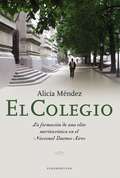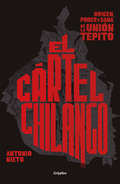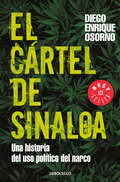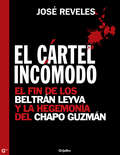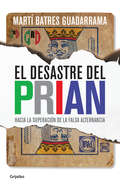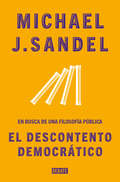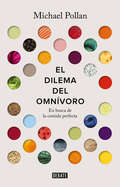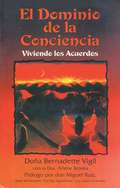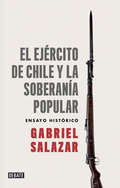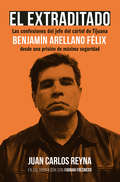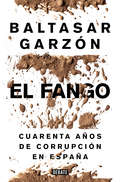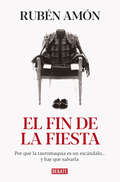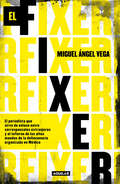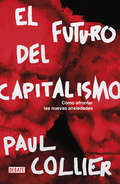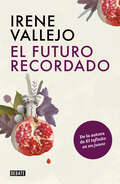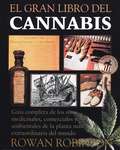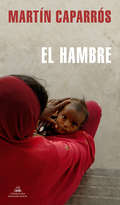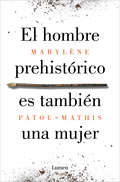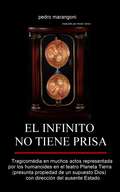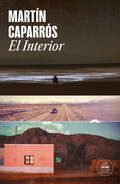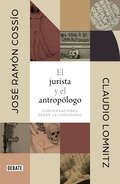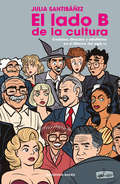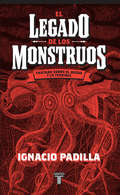- Table View
- List View
El colegio: La formación de una elite meritocrática en el Nacional Buenos Aires
by Alicia MéndezUn ensayo a partir de entrevistas a ex alumnos de distintas promocionessobre el Colegio Nacional de Buenos Aires como el modelo meritocráticopor excelencia formador de elites de la Argentina desde hace 150 años. En un país como la Argentina, marcado por discontinuidades políticas einstitucionales, con cambios a menudo abruptos de orientacionesideológicas, el Colegio Nacional de Buenos Aires se mantuvo durante 150años como un modelo educativo destinado a formar a buena parte de laselites. ¿Cómo fue posible? ¿Cómo, pese a todas las mudanzas de un paíssiempre imprevisible, esta institución emblemática logró conservarciertas características que la identifican en el imaginario nacional?Una profunda y extensa investigación unida a una prosa ágil y amenapermiten a Alicia Méndez brindar una imagen renovada del Nacional BuenosAires que resulta, a la vez, un instrumento para pensar a la Argentinamoderna. Un colegio que formó a dos premios Nobel, a tres presidentes ya tantas figuras significativas de la vida pública, de la Generación del80 a Montoneros, y que muestra desde su fundación los rasgos de unainstitución sorprendentemente abierta en términos de origen social,residencial y de género de sus estudiantes.A través de entrevistas a ex alumnos y un amplio trabajo en el archivodel Colegio, combinados con textos autobiográficos y otras fuentesdocumentales, la autora reconstruye de modo fascinante tanto lastrayectorias individuales como las formas de sociabilidad en ese mundosingular -del Buenos Aires- un lugar concebido por muchos como una«isla de mérito en un país en el que corren otros aires».
El cuento de la bandera tachonada de estrellas
by Candice Kramer Karen Leon Alan Kramer Paul LevenoPerform this script about two children who travel back in time to be with Francis Scott Key as he writes "The Star Spangled Banner. "
El cártel chilango: Origen, poder y saña de la Unión Tepito
by Antonio NietoEn el corazón de la capital de México -la ciudad que alguna vez estuvo "prohibida" para los capos del narco- nació La Unión Tepito, el primer y único cártel chilango. No es una pandilla, no es una célula de un grupo mayor ni tampoco una banda doméstica, sino un auténtico cártel que logró apoderarse del centro del país, justo en las narices de las más altas autoridades. ¿Cómo lo hizo? Ejerciendo una violencia como nunca se había visto, con el liderazgo de un hombre del que poco o nada se sabía, con una red de lavado poderosísima y la apatía de dos administraciones capitalinas. Ningún trabajo periodístico había escarbado tan profundo en las entrañas de La Unión Tepito, en la personalidad de sus líderes, en las matanzas que ha perpetrado, en sus alianzas y sus impunidades. Con documentos altamente confidenciales, testimonios de víctimas, de ex miembros del cártel y acceso al contenido de teléfonos celulares de sus integrantes, este libro revela el verdadero rostro de La Unión, y el reguero de sangre y dinero sucio que ha dejado a su paso.
El cártel de Sinaloa
by Diego Enrique OsornoCrónica del surgimiento, desarrollo y transformaciones del Cártel de las drogas más peligroso de México. El cártel de Sinaloa explica y detalla el mundo del narco: desde los pioneros del negocio como Pedro Avilés, los sicarios desalmados que matan gobernadores como el Gitano, policías corruptos al estilo Guillermo González Calderoni, hasta hechos sorprendentes como la expulsión masiva de chinos durante la segunda década del siglo XX, las primeras rutas trasnacionales de la cocaína, o la fuga de Joaquín el Chapo Guzmán. Aquí todos cuentan su versión sobre el lucrativo tráfico de drogas en Sinaloa, que es la historia misma del narcotráfico en México. Este libro da voz al hijo de un narcotraficante que relata cómo es vivir con ese estigma; también aparece un abogado de la mafia que abre puertas de tribunales y prisiones de máxima seguridad; soldados oaxaqueños que erradican cultivos de mariguanaen la sierra de Badiraguato; un comandante guerrillero del ERPI en Guerrero, o un político y empresario millonario de San Pedro Garza García, Nuevo León. Todos ellos son piezas clave en el mundo del narco y aquí ofrecen testimonios reveladores. La PGR, la DEA y el Ejército mexicano lo hacen a través de expedientes oficiales, algunos publicados por primera vez en este libro. Se da a conocer asimismo la versión directa de capos como Miguel Ángel Félix Gallardo, el Jefe de Jefes, cuyos escritos de puño y letra acusan a las autoridades de ser las auténticas responsables de crear y organizar la distribución de los llamados cárteles. Diego Enrique Osorno, a través de una ágil narración periodística, nos ofrece el más completo panorama del cártel fundacional del narcotráfico y uno de los más poderosos que han existido en México.
El cártel incómodo: El fin de los Beltrán Leyva y la hegemonía del Chapo Guzmán
by José Reveles Morado"Si algo indigna a los mexicanos es observar cómo el gobierno se coloca al nivel de la vesania y agresividad de los criminales." José Reveles Cuerpos decapitados, "pozoleados", descuartizados; narcomantas, cartulinas y videos con mensajes de violencia o denuncias contra el gobierno por atacar sólo a unos traficantes y encubrir y consentir a otros; ataques armados a centros de adicción, a discotecas, a fiestas particulares de jóvenes; amenazante paramilitarismo. Todo forma parte del escenario de nuestra violenta cotidianidad desde que el gobierno federal le declaró la "guerra" al narcotráfico, pero sin emplear inteligencia policiaca o militar, sin desmantelar redes financieras, lavado de dinero y empresas fantasmas. Siguen intactas las estructuras políticas que brindan protección a la criminalidad. De eso y más habla El cártel incómodo: del surgimiento de los Beltrán Leyva y de por qué su rompimiento con el cártel de Sinaloa; delbrillo efímero de esta organización durante cinco años; de la muerte o la cárcel que los borró del mapa, con lo cual se fortaleció Joaquín el Chapo Guzmán, a quien ellos pretendían aniquilar. Todo esto apunta a favorecer la hegemonía del cártel de Sinaloa, hoy por hoy el cártel incómodo de los gobiernos panistas. José Reveles desnuda en estas páginas la verdad detrás del discurso oficial. Nos acerca al espejo de una terrible realidad que las élites política y económica no quieren mirar. Contiene los informes del Cisen que Alfredo Jiménez Mota, periodista de El imparcial de Hermosillo, utilizó en sus publicaciones antes de ser desaparecido en 2005.
El desastre del PRIAN
by Martí BatresEn este libro, Martí Batres -político y académico de larga trayectoria, actualmente dirigente de Morena- designa como PRIAN a la unión no declarada de dos partidos políticos, PRI y PAN, obstinados en presentarse ante el electorado como antagónicos. Con hondura crítica y datos concretos expone claramente cómo los proyectos de ambos son idénticos y no tienen más finalidad que propugnar y concretar las reformas estructurales de índole neoliberal. Sin embargo, apoyado en referencias estadísticas, sostiene que este propósito mancomunado ha hundido al país en el estancamiento y la pobreza. El desastre del PRIAN no se queda en la crítica: desarrolla propuestas concretas como la disminución del salario de la clase política; el impulso no a la gran empresa sino a la mediana, pequeña y micro; lucha contra la corrupción, recuperación salarial, diversificación de las exportaciones, práctica de una democracia participativa; así como otras medidas políticas, sociales y económicas. Sólo de esta forma, concluye el autor, podrá abandonarse el modelo del PRIAN y cambiar el rumbo de la nación.
El descontento democrático: En busca de una filosofía pública
by Michael J. SandelEl profesor de filosofía más famoso del mundo analiza los peligros a los que se enfrenta la democracia. «Una profunda contribución anuestra comprensión de los descontentos actuales».The Wall Street Journal La división, la crispación y la polarización han dado un vuelco al escenario político internacional. El murmullo de descontento que comenzó en los años noventa ha llevado a ciertos sectores de la sociedad a manifestar una clara animadversión hacia el proyecto globalizador de las élites. Gobernantes y ciudadanía parecen preferir el libre mercado en lugar de una democracia saludable. Conceptos como «libertad» o «civismo» han dejado de generar consenso y se han convertido más que nunca en armas arrojadizas entre adversarios electorales. Mientras, aumentan las desigualdades sociales, la injusticia racial y el hiperpartidismo, y las fronteras nacionales pierden su relevancia económica e identitaria. En esta nueva edición de El descontento democrático, publicado por primera vez en 1996 y actualizado a los nuevos tiempos, Michael J. Sandel explora de un modo certero e iluminador las causas de la profunda decepción que se ha apoderado de la vida pública en las democracias occidentales. A través del caso de Estados Unidos, nos proporciona herramientas para comprender cómo en tiempos de guerras culturales, donde cada vez es más difícil que surjan movimientos reformistas de amplia base social, nuestra tradición cívica puede ayudarnos a imaginar una alternativa al sistema neoliberal y tecnocrático en que estamos instalados, donde la identidad y los ideales comunes están cada vez más devaluados. La crítica ha dicho:«Provocador. Defiende que las democracias modernas no podrán sostenerse a menos que encuentren la manera de hacer frente a la economía global y, al mismo tiempo, dar expresión a las identidades distintivas de sus pueblos».The New York Times «Una profunda crítica del liberalismo estadounidense que, a diferencia de otroslibros sobre el tema, busca su restauración como ética política. Un libro repleto de ideas valiosas».Kirkus Reviews «Entre los méritos que lo hacen único están la admirable combinación de análisis conceptual e investigación histórica, y la impresión de una mente genuinamente reflexiva y un espíritu generoso».Canadian Journal of Philosophy «Una de las obras más poderosas de filosofía pública aparecidas en los últimos años. Un diagnóstico brillante».U.S. News & World Report«Un libro importante sobre el significado de la libertad. El análisis es soberbio».The Washington Post Book World «Pocos libros son tan relevantes un cuarto de siglo después de su aparición como cuando se publicaron, pero Michael Sandel ha conseguido que este clásico lo sea aún más».Samuel Moyn «Profundamente perspicaz, nunca ha sido más oportuno que hoy. Una lectura esencial —y esperanzadora— para quienes se preguntan si nuestro experimento democrático sobrevivirá en el siglo XXI».Greta R. Krippner
El dilema del omnívoro: En busca de la alimentación perfecta
by Michael PollanEn este revolucionario libro, Michael Pollan, uno de los escritores más brillantes, originales y elocuentes de Estados Unidos, aborda la aparentemente sencilla pregunta de qué deberíamos comer, ofreciéndonos unas respuestas que tienen profundas implicaciones políticas, económicas, psicológicas e incluso morales para todos nosotros. ¿Qué cenaremos hoy? Nos hemos confrontado a esta pregunta desde que el hombre descubrió el fuego, pero para Michael Pollan la manera en que la abordamos hoy en día podría llegar a determinar nuestra supervivencia en cuanto a especie. El hecho de que seamos omnívoros y podamos ingerir todo tipo de alimentos hace que nuestro acto de decidir qué queremos comer se vuelva un dilema, sobre todo ante la abundancia de productos que nos ofrece el desconcertante y traicionero mercado alimenticio. Cuando escogemos nuestro tipo de alimentación, no solamente entra en juego la salud propia o la de nuestros hijos, sino la de todo el medioambiente. Escrito de manera excelente y profusamente argumentado, El dilema del omnívoro promete cambiar nuestra percepción sobre las políticas alimenticias y el placer de la comida.
El dominio de la conciencia: Viviendo los acuerdos
by Don Miguel Ruiz Arlene Broska Doña Bernadette VigilReveals the authentic tradition of Toltec self-mastery • By the working partner of don Miguel Ruiz • Provides a program of 11 Agreements for continuing the spiritual journey The author guides readers through the effective training techniques practiced by Toltec warriors for centuries: mental and physical exercises in visualization, breath work, and meditation—the keys to unlocking the potential of the mind. These techniques allow readers to move through the three levels of ascending spiritual consciousness, from Jaguar Knight and Eagle Knight through Nagual, the level of enlightened master. By following the practices of the spiritual warrior, readers will experience the peace that comes from breaking free of self-limiting thoughts in order to fulfill their true potential. This book also challenges readers to look beyond personal change to transform the collective dream of the planet. Doña Bernadette Vigil is a professional artist and her work has been widely exhibited. She presents Toltec wisdom workshops with Nagual don Miguel Ruiz throughout the United States and abroad. She lives in New Mexico.
El ejército de Chile y la soberanía popular: Ensayo Histórico
by Gabriel Salazar VergaraLa investigación más importante de Gabriel Salazar aborda la historia del ejército de Chile y su relación con la ciudadanía desde la Independencia hasta nuestros días. En un trabajo monumental escrito como ensayo histórico, Gabriel Salazar recorre la historia del ejército de Chile y su rol en los acontecimientos políticos y sociales ocurridos durante los últimos doscientos años. Desde sus distintas mutaciones ocurridas durante el siglo XIX (del ejército libertador de O'Higgins hasta el ejército privado que derrocó al gobierno de Balmaceda), pasando por el caudillismo ibañista, las sublevaciones del general Viaux al «frustrado caudillismo del capitán general Augusto Pinochet», Salazar indaga en su relación con la clase política y civil, así como con su relación con el bajo pueblo (la "pacificación" y el "palomeo"), para finalmente ofrecer un balance histórico de su cuestionado protagonismo en la historia nacional.
El extraditado. Benjamín Arellano Félix
by Juan Carlos Reyna Farrah Fresnedo"Si para algo soy bueno, es para hacer la guerra..."El extraditado constituye el retrato implacable sobre Benjamín Arellano Félix, jefe máximo del Cártel de Tijuana, una de las organizaciones criminales más poderosas durante la década de los noventa. Desde una perspectiva cercana, la historia muestra el testimonio directo del protagonista, siendo la primera vez que un capo mexicano ofrece su versión de los hechos desde la extradición en Estados Unidos.Con un estilo vertiginoso, siempre exento de juicios morales, Juan Carlos Reyna despliega una impactante crónica donde la voz del personaje principal confluye con información inédita de diversos expedientes judiciales. Así, el lector va descubriendo los entresijos de varios hitos en la historia del narcotráfico, como la balacera de la discoteca Christine, el asesinato del cardenal Posadas Ocampo o la detención del propio Benjamín Arellano en Puebla."Tuve la impresión -afirma el autor- de que la historia de los Arellano Félix, entrecruzada con la de México en general, era una sucesión brutal de ajusticiamientos." Situado más allá de la trinchera periodística, en ese recorrido lleno de velocidad y desconcertantes giros se ponen al desnudo las entrañas del cártel: sus nexos empresariales-políticos, sus jerarquías y modos de operar. El resultado es una compleja y profunda visión sobre la acumulación de poder a través del feroz ejercicio de la violencia."A mí me extraditó el PAN, porque a mí el PRI no me extradita..."
El fango: Cuarenta años de corrupción en España
by Baltasar GarzónJuan Guerra, Bárcenas, Pujol, caso Noos... un recorrido por los casos de corrupción más importantes de los últimos cuarenta años para extraer las lecciones de cómo combatir y prevenir la corrupción. El fango es por tanto un libro necesarioLa corrupción es un mal que ha socavado los cimientos de la democracia española. Aunque los escándalos han emergido en momentos de crisis económica como los primeros 90 y desde el 2009, se puede trazar una línea continua que desde las postrimerías del franquismo muestra cómo las fallas del sistema del control facilita y en ocasiones propicia un aprovechamiento ilícito y muy lucrativo.La experiencia de Baltasar Garzón en la lucha contra la corrupción la ha permitido trazar este recorrido que arranca con el caso Matesa y termina en la actualidad y cubre todos los niveles administrativos, todas las regiones y todos los sectores económicos. Para prevenir la corrupción es fundamental entender cómo se origina y cómo funciona, sus mecanismos ocultos de la corrupción, por qué es tan difícil combatirla y qué reformas son necesarias para ponerle fin.
El fin de la fiesta: Por qué la tauromaquia es un escándalo...y hay que salvarla
by Rubén Amón DelgadoUn controvertido ensayo sobre la realidad de la tauromaquia y su porvenir. La tauromaquia se ha distanciado de la sociedad tanto como la sociedad se ha distanciado de la tauromaquia. Median entre la una y la otra toda suerte de malentendidos. Puede que el más polémico sea el político, porque se utilizan los toros como argumento de discordia en el caldero identitario. Y puede que el más insólito sea el medioambiental, pues no se explica la hostilidad del ecologismo cuando los toros representan un territorio de excepción y de conservación formidables. La crisis de la tauromaquia no es nueva. Forma parte de su naturaleza, pero es cierto que la pandemia del coronavirus ha deteriorado y cuestionado la viabilidad del acontecimiento tal como lo conocemos o tal como ha sobrevivido. Los toros necesitan un ejercicio de honradez y de transparencia. Otra cuestión es que la tauromaquia represente razones suficientes para escandalizar una sociedad que reniegan de la muerte, de los ritos. Una sociedad secularizada y aséptica que se encomienda a héroes accidentales y que abjura de la jerarquía, de la masculinidad y de las manifestaciones creativas extremas. La gran paradoja es que los toros se perciben como un fenómeno rancio y anticuado cuando representan la transgresión y la vanguardia. La causa no está perdida. Es más, los dogmas prohibicionistas, el acoso político y la sublimación de las sociedades incoloras, inodoras e insípidas convierten la tauromaquia en un espacio de resistencia y de incomodidad que la hacen más atractiva que nunca. Los toros ponen a la sociedad delante de sus tabúes y sus congojas. De tanto querer prohibirse y de tanto tratarse con hipocresía, se han convertido en subversivos, aunque nunca han dejado de serlo. Este ensayo profundiza en las razones del desencuentro. Puede que el título sea crepuscular, pero entre líneas se propone un desenlace esperanzador.
El fixer
by Miguel Ángel VegaEl periodista que sirve de enlace entre corresponsales extranjeros y el infierno de los altos mandos de la delincuencia organizada en México. Un Fixer es un periodista conectado con jefes de cárteles, sicarios, narcomenudistas, cocineros de droga y agentes federales, miembros del ejército y policías. Su labor es abrirles paso a reporteros o documentalistas de Estados Unidos, Alemania, Francia, Holanda, Rusia de todo el mundo, para que realicen su trabajo en los lugares más violentos donde opera la delincuencia organizada en México. Miguel Ángel Vega, periodista de análisis social y director de cine, uno de los Fixers con más prestigio en el mundo, revela en este libro su historia: los peligros que enfrenta para lograr entrevistas, accesos fatídicos, lugares nunca visitados por ningún medio de comunicación. Detalla la angustia que viven los Fixers cuando deben librar a sus colegas internacionales de un levantón, de los interrogatorios brutales y de las amenazas de quienes conforman el Cártel de Sinaloa. El Fixer no es un libro de ficción la supera por mucho, sino el testimonio del reportero apasionado que libra atentados y jamás pierde la fe. No existe otro periodista que conozca tan bien a gente cercana al Mayo Zambada, a mujeres que han visto morir a sus parejas y deciden vengarlos con sus AK-47 o R-15. El autor comparte anécdotas delirantes: una comida con la madre del Chapo y uno de sus hijos; la negociación con matones del Cártel de Sinaloa para que dejen de golpear a corresponsales rusos o encuentros y conversaciones con esposas de capos, narcas, amantes de delincuentes peligrosos. El lector tiene en sus manos las confesiones de un Fixer nunca antes escritas, sin duda, un libro trepidante e incomparable.
El futuro del capitalismo: Cómo afrontar las nuevas ansiedades
by Paul CollierPese a las muchas críticas que soporta el sistema capitalista, nadie parecía tener un plan realista para repararlo. Hasta ahora. En su nuevo trabajo, tan polémico como apasionado, el célebre economista Paul Collier plantea, mediante un enfoque racional, originales métodos para salvar las escisiones económicas, sociales y culturales que gobiernan el seno de la sociedad Occidental, y nos invita a ser testigos de su experiencia personal enfrentando estas brechas. Partiendo de sus propias soluciones y de las ideas de algunos de los sociólogos más distinguidos a nivel mundial, Collier nos hace poseedores de las claves que pueden salvar al capitalismo de sí mismo y que pueden liberarnos a todos del bagaje intelectual del siglo xx. Este provocador libro nos da las claves para reparar el sistema. Reseñas:«La política de centroizquierda lleva treinta años buscando un texto que aclare de una vez por todas lo que está pasando con la economía de mercado. Con este libro lo han encontrado.»John Kay «Para los ciudadanos adinerados, el capitalismo es una fuente de riqueza interminable, mientras que, para muchos otros, es un sistema del todo inefectivo. Paul Collier despliega en este libro toda su pasión, en igual medida que su pragmatismo y su conocimiento de la economía, para proponer una solución a las divisiones causantes de la inestabilidad de muchísimos países occidentales.»Mervyn King «Estos tiempos necesitan desesperadamente la visión de Paul Collier. Su nueva obra restaura el sentido común sobre nuestra percepción de la moralidad, al mismo tiempo que describe su papel fundamental en el funcionamiento de familias, organizaciones y naciones. Es la obra más revolucionaria sobre ciencias sociales desde Keynes. Esperemos que sea igual de influyente.»George Akerlof «Esta obra es una atrevida provocación al intelecto. En ella, Paul Collier, el distinguido economista, se aventura en el terreno de la ética para explicar por qué el capitalismo se ha corrompido y para aportar sus soluciones. Si queremos salvar la brecha entre las élites metropolitanas y el resto de ciudadanos, Collier sostiene que debemos redescubrir el sentido de la pertenencia, del patriotismo y de la reciprocidad. Mientras proporciona creativas soluciones para este impasse, nos enseña cómo la máxima expresión de la economía es inseparable de la moral y de la filosofía política.»Michael Sandel «Este libro es admirable en muchos sentidos: su amplísima aproximación ética a la economía, el abanico de temas económicos, sociales y políticos que trata, y el análisis de la actual economía de aglomeración.»Martin Wolf, Financial Times «Este libro, increíblemente coherente y conciso, es un grito de ira apenas reprimido [...]»Dominic Lawson, The Sunday Times «No es una lectura ligera, pero es sin duda imprescindible.»David Goodhart, Evening Standard «Collier nos regala una obra excepcional en un contexto marcado por el agitado debate sobre el capitalismo y su futuro. Las anécdotas personales y su discurso sin tapujos estabilizan su ya logrado equilibrio entre teoría y práctica y hacen de este libro algo realmente único.»Mehmet Emin Bayram, London School of Economics Review of Books «El futuro del capitalismo es un libro ambicioso y estimulante. [...] Comparto muchas de las ideas que Collier expone. La idea central, según la cual debemos procurar atender las obligaciones que tenemos para con nuestros congéneres, me caló muy hondo.»Bill Gates «El futuro del capitalismo posee el encanto discursivo de una clase magistral impartida por un catedrático de Oxford exhaustivamente documentado.»Steven Pearlstein, Th
El futuro recordado
by Irene Vallejo«Los libros de Irene Vallejo, claros e inteligentes, se leen muy bien e invitan a pensar. En la mejor línea humanista.» -CARLOS GARCÍA GUAL La aparente contradicción que da título a este libro es la premisa central de los breves ensayos que contiene: la certeza de que en cada paso que damos está la huella de un mundo que parece haberse quedado atrás en el tiempo, pero que vive y respira en cada uno de nuestros gestos e ideas. En estos ensayos, Irene Vallejo entabla un diálogo con diversas personalidades de la historia y con la cultura que nos han legado; son al mismo tiempo un derroche de erudición sin pretensiones y un homenaje al sutil arte de contar historias. De la filosofía a la geografía, de la literatura a los deportes, de la historia a la vida cotidiana, estos ejercicios narrativos son pistas que nos ayudan a comprender mejor el mundo que habitamos y nos reconcilian con la memoria de aquellos que, antes que nosotros, se hicieron las mismas preguntas que hoy nos mueven.
El gran libro del cannabis: Guía completa de los usos medicinales, comerciales y ambientales de la planta más extraordinaria del mundo
by Rowan RobinsonCannabis sativa has been called the world's most versatile plant. Materials made from hemp fiber have been discovered in tombs dating back to before 7000 BC. During the Middle Ages hemp was used to treat fevers, insomnia, and malaria. Columbus's ships had sails of hemp, and during colonial times it was universally grown because its strong fibers made superior ropes, sails, cloth, and paper. In fact, hemp was used for money in most of the Americas from 1631 until the early 1800s, and the original drafts of the Declaration of Independence and the Constitution were written on hemp paper. As a food, the oil from hemp seeds has the highest percentage of essential fatty acids and the lowest percentage of saturated fats. Britain and Canada have recently lifted bans on growing industrial hemp and today it is reappearing in the marketplace in an amazing array of products: from lip-salve, jeans, salad oil, and cheese to paper products, composite fiberboard, and biomass fuel. This illustrated, easy-to-read guide covers all aspects of hemp: • The history of its cultivation worldwide• Its role as a source of renewable energy and as an alternative for paper manufacturing and fossil fuels• Its versatility as a fiber• Its many nutritional and medicinal uses• Examines the physiological and psychological effects of marijuana use in recreation and therapy • A comprehensive resource section includes information on organizations involved in legalizing hemp, product suppliers, and an annotated bibliography.
El hambre
by Martín CaparrósUn libro incómodo y apasionado. Es una crónica que piensa, un ensayo que narra y un panfleto que denuncia la urgencia de una vergüenza sostenida y busca la manera de acabar con ella. «Conocemos el hambre, estamos acostumbrados al hambre: sentimos hambre dos, tres veces al día. No hay nada más frecuente, más constante, más presente en nuestras vidas que el hambre –y, al mismo tiempo, para muchos de nosotros, nada más lejano que el hambre verdadera.» Para entenderlo, para contarlo, Martín Caparrós recorrió la geografía del hambre, desde la India, Bangladesh, Níger, Kenia y Sudán hasta naciones desarrolladas como Estados Unidos y España. Allí encontró a quienes, por distintas razones –sequías, pobreza extrema, guerras, marginación–, sufren hambre. De sus historias está hecho El Hambre, y de las historias de quienes trabajan en condiciones muy precarias para paliarla, y las de quienes especulan con los alimentos y hambrean a tanta gente. Y, por desgracia, sigue tan vigente. Seis años después, pandemia mediante, el problema se ha profundizado: por eso presentamos una nueva edición revisada y actualizada de esta investigación exhaustiva sobre los mecanismos que hacen que casi mil millones de personas no coman lo que necesitan. La crítica ha dicho...«El Hambre de Marín Caparrós es mucho más que un ensayo, mucho más que una novela. Caparrós usa la literatura para llevarnos a un infierno de realidad, una realidad lejana, de la cual Caparrós es muy consciente.»Roberto Saviano, 2015 «El no-lector de El Hambre se está privando de un conocimiento esencial [...] Daría una mano por haberlo escrito.»Juan José Millás «Impresiona, incomoda y fascina. Consigue noquear a nuestra tan acomodada civilización.»Núria Escur, La Vanguardia «Caparrós es colosal en esos terrenos resbaladizos donde las cosas dejan de encajar en los moldes correctos como, por ejemplo, el momento en que un hombre decide sacar a su hija desnutrida del hospital asiático en el que está internada porque, según él, la nena está bien y, además, necesita que su mujer regrese a casa. De esa manera, una criatura que pudo salvarse es condenada a una muerte casi segura por su propio padre. Es en esos huecos vertiginosos, cuando se busca frenéticamente a quién calzarle la culpa, por donde el libro expulsa sus venenos más fuertes. Caparrós mira de cerca a la medicina occidental, a las religiones, a las ONG, a los Gobiernos, a las esposas, a los maridos, a sí mismo, hasta que no queda nada en pie.»Leila Guerriero, El País «El Hambre habla de política, de pobreza, de miseria, de economía, de oenegés, de la ONU y de la FAO, de multinacionales sin escrúpulos que negocian con los alimentos, de emigración, de la vergüenza de las villamiserias, de fórmulas presuntamente milagrosas, de la epidemia de obesidad en Estados Unidos -otra expresión de un mismo fenómeno- de la expansión china, de... Este libro habla de muchas cosas, pero deja claro que el hambre es en todo el mundo una experiencia que demuestra el fracaso de nuestra civilización.»Xavier Moret, El periódico «Sobre todo en esa obra maestra de la no ficción que es El Hambre, Caparrós ha dejado claro que su apuesta es global, universal.»Jorge Carrión, Clarín «El autor de El Hambre (Anagrama, 2015), considera este libro un fracaso desde el arranque: "Una exploración del mayor fracaso del género humano no podía sino fracasar". Sin embargo, el impacto y alcance de la obra sugieren que ha encontrado la tecla adecuada para tratar la cuestión. Es su aportación en la lucha contra "el hambre más canalla de la historia". Esa que hoy día no depende de la capacidad humana de obtener alimento —anualmente se produce más del doble de la comida necesaria para alimentar a todo el planeta— sino de voluntad política o prácticas
El hombre prehistórico es también una mujer: Una historia de la invisibilidad de las mujeres
by Marylène Patou-MathisUna deslumbrante investigación hasta los orígenes del ser humano para sacar a la mujer de la caverna. No, las mujeres prehistóricas no se pasaban el día barriendo la cueva y cuidando de los hijos mientras esperaban que los hombres regresaran de cazar. Ellas también perseguían a grandes mamíferos, fabricaban herramientas y joyas, construían viviendas y exploraban formas de expresión simbólica. Los vestigios arqueológicos demuestran que las mujeres neandertales usaban la lanza; gracias al análisis del ADN sabemos que algunos esqueletos enterrados con sus armas pertenecían a jóvenes robustas que cazaban, y también está atestiguada su intervención artística en las paredes de las cuevas. Tampoco hay indicios de que, en las sociedades del Paleolítico, un periodo que se extiende durante cientos de milenios, se considerara a las mujeres inferiores y subordinadas a los hombres. ¿Por qué, entonces, sigue vigente la imagen que divulgaron los primeros prehistoriadores en el siglo XIX? Basta retroceder en el tiempo para comprender que la jerarquización entre los géneros solo se fundamenta en prejuicios que es urgente deconstruir. De la mano de una de las mayores especialistas en el comportamiento de los neandertales, esta fascinante investigación de arqueología de género nos revela una prehistoria como nunca la habíamos leído. La crítica ha dicho...«Patou-Mathis lanza el sílex contra la pared y suelta un bombazo: las mujeres han sido las grandes olvidadas de la prehistoria.»Sophie Carquain, Version Femina «Un libro poderoso, [...] saludable e inspirador [...] que debemos incorporar a nuestro patrimonio (o más bien a nuestro “matrimonio”).»Rachel Mulot, Sciences et Avenir «No resulta habitual que una científica se convierta en una estrella de los medios de comunicación, pero es lo que ha ocurrido con la investigadora francesa Marylène Patou-Mathis [gracias a] su sentido del humor y su forma franca y directa de explicar asuntos delicados [de la prehistoria].»Guillermo Altares, El País Semanal «Este libro abre un nuevo camino al pensamiento y se lee con fruición. Rebosante de información, [...] es sólido como un menhir.»Françoise Cariès, MAG Centre «Un ensayo valioso que nos da las claves para renovar, con las gafas de la prehistoria, nuestra visión de los géneros y los individuos.»Camille Crosnier, La Terre au carré (France Inter) «Un libro inteligente que crea un espacio real para las mujeres.»Fabienne Chauvière, Les Savanturiers (France Inter) «Erudito y fascinante.»Laëtitia Vitaud, Welcome to the Jungle «Una obra cautivadora.»Baudouin Eschapasse, Le Point «En este libro deslumbrante, Marylène Patou-Mathis deconstruye nuestro imaginario colectivo y cuenta una nueva historia de las mujeres.»Guy Duplat, La Libre Belgique «Marylène Patou-Mathis nos trae noticias felices que nos proporcionan armas nuevas para luchar contra los argumentos naturalistas.»Dorothée Werner, Elle «Patou-Mathis lanza el sílex contra la pared y suelta un bombazo: las mujeres han sido las grandes olvidadas de la prehistoria.»Sophie Carquain, Version Femina «Un libro que llega en el mejor momento.»Caroline Bousquet, Maze «Patou-Mathis se carga todos los clichés.»Margaux Habert, Femina
El infinito no tiene prisa
by Pedro Marangoni Annie CeronEl infinito no tiene prisa presenta una visión crítica sobre la actual sociedad y sus tendencias en el ámbito pólitico, religioso, social, evolutivo etc.
El interior
by Martín CaparrósEl Interior logra describir con más eficacia que cualquier imagen un país deshecho y, al mismo tiempo, siempre por hacer. El Interior es la aventura de recorrer y descubrir buena parte de la Argentina. Los espacios más maravillosos, los personajes más diversos, los esfuerzos por hacer un país que se deshace, los rasgos de cada lugar, sus diferencias, sus comidas y bebidas y canciones, sus historias de crímenes y corruptelas, sus santitos y santitas y demonios,el vacío que amenaza en todas partes: un país que todavía no termina de construirse y que, tan a menudo, se asoma al precipicio. En sus páginas, poemas y reflexiones, análisis y datos, diálogos y situaciones, paisajes y personajes se combinan para armar el gran rompecabezas. Su forma, donde se encuentran tantos recursos de la mejor literatura, ha sido retomada por los mejores cronistas de la lengua. Críticas:«El interior es una road movie en forma de libro que puede ser leída como la "gran novela argentina". Esa que se espera y nunca llega».Jorge Fernández Díaz, La Nación «Martín Caparrós quiso meter un país entero -la Argentina, nada menos- en una sola obra, y esos esfuerzos no toleran términos medios: un país solo cabe en un aforismo o en un tocho de setecientas páginas y letra chata. La opción fue la segunda, y el resultado, excepcional».Nadal Suau, El Cultural«Un mapa de tribulación social, un espacio que, a pesar de la alborotada época de información en que vivimos, permanecía oculto, desconocido, y que Caparrós ha decidido conocer confrontándolo con ojos, oídos y la terquedad de entender lo incomprensible».Francisco Solano, Babelia
El jurista y el antropólogo: Conversaciones desde la curiosidad
by José Ramón Cossío DíazEL DERECHO Y LA ANTROPOLOGÍA TIENEN ALGO EN COMÚN: AMBAS DISCIPLINAS SE DAN LA ESPALDA CON FRECUENCIA La conversación es el arte de afilar el conocimiento propio usando el conocimiento de alguien más. Siguiendo este espíritu, el jurista José Ramón Cossío y el antropólogo Claudio Lomnitz han construido, mediante el diálogo, un espacio de asombro y erudición sobre sus respectivas disciplinas: «Cossío quería entender mejor la sociedad en que opera el derecho. [...] Y Lomnitz buscaba entender las regulaciones que imperan sobre la vida cotidiana», se lee en la «Introducción» de esta obr A partir de estas motivaciones se desata un caudal de reflexiones críticas. Debaten, así, sobre la arrogancia de ciertos planteamientos jurídicos, el enclaustramiento de la antropología, la imposibilidad de empatar el ordenamiento legal con la realidad, los cuellos de botella para entender o resolver el conflicto social que atraviesa México, y analizan qué tan útil -o inútil- es la idea misma de Estado de derecho en nuestra actualidad. A lo largo de la obra, escrita durante la pandemia, se va esbozando una triple invitación: asombrarse de la antropología y el derecho, buscar la urdimbre profunda entre los distintos conocimientos, y convocar la potencia creativa y humanizante de la palabra. Ensayistas modernos;antropología y juridicas;planetamientos juridicos;antropologia cerrada;realidad legal y realidad empirica;conflictos sociales actuales;estado de derecho;que leer para entender de politicas;lecturas de politica;como entender el mundo actual;libros de derecho para adultos;[Críticas/Reseñas]
El laberinto de la choledad: Páginas para entender la desigualdad
by Guillermo NugentUn libro fundamental para reflexionar sobre la compleja estructura social de las formas de clasificación, discriminación y racismo en la sociedad Desde su primera edición en 1992, El laberinto de la choledad, del sociólogo Guillermo Nugent, se ha convertido en un texto fundamental para reflexionar sobre la compleja estructura social de las formas de clasificación, discriminación y racismo que se evidencian en las costumbres y prácticas cotidianas. Sus páginas muestran cómo a través del lenguaje en la conversación ciudadana se revelan contradicciones entre lo que decimos y hacemos, la manifestación de un orden tutelar y una jerarquía que encasilla a los ciudadanos en roles determinados y establece límites imaginarios entre ellos, casi imposibles de cruzar. En ese sentido, sostiene Nugent, la fuerza del disimulo y la ambivalencia en los tratos son consecuencias de una cultura que, de manera constante, refuerza la desigualdad social y reprime las semejanzas. Esta nueva edición de El laberinto de la choledad busca motivar una discusión pública sobre el orden actual de la sociedad peruana. Incluye, además, el texto inédito: "La palabra y la piel", que complementa el conjunto de ensayos que analizan los privilegios, los abusos del poder, las violencias y las memorias de los discursos racistas. Se convierte, de este modo, en la edición definitiva de un libro central de las ciencias sociales, de vigorosa vigencia.
El lado b de la cultura: Codazos, descaro y adulterio en el México del siglo XX
by Julia SantibáñezPasa, lectora, lector, estás en tu fiesta. Más que un libro, este objeto es un carnaval de cincuenta estaciones que desfila tras las bambalinas de la cultura mexicana. En él participan Tin Tan y Pita Amor, María Félix y Monsiváis, Piporro y Tongolele, Nahui Olin y Jorge Ibargüengoitia, los beats y Marilyn Monroe, Vitola y José Revueltas. Entre muchos, muchos otros. Mientras pasan, nos van contando de sus vicios, supersticiones, sus pleitos y apodos, los cuadrángulos amorosos que formaron y los cabarés que visitaron. Guiados por la insaciable curiosidad de Julia Santibáñez, nos enteramos de quiénes fueron huéspedes de Lecumberri y quiénes invitados a la casa de Carlos Fuentes; qué escritores la hicieron de actores y qué libros y películas gozaron de la mercadotecnia inversa de la censura y por qué. Encuentra aquí lo que los libros ceremoniosos nunca dirán sobre escritores, artistas e intelectuales.
El legado de los monstruos. Tratado sobre el miedo y lo terrible
by Ignacio Padilla¿Por qué y a qué tenemos miedo? ¿Es el miedo un instinto, una herida o una herramienta? ¿Cómo es posible que en algunos momentos podamos disfrutarlo e, incluso, lleguemos a buscarlo?A partir de estas preguntas, Ignacio Padilla examina, desde diversas perspectivas, una de las emociones humanas más profundas y primitivas para desarrollar una verdadera teoría del miedo y lo monstruoso.La primera parte de El legado de los monstruos analiza el potencial del miedo como combustible estético y sociopolítico. La ficción -ya sea la ficción épica, religiosa, literaria o cinematográfica- nos permite procesar la energía liberada por el miedo y convertirla en un impulso creador. Esto lo han sabido y aprovechado numerosos artistas de todas las épocas, pero también muchos políticos y mercadólogos, que han lucrado y gobernado con el miedo.En la segunda parte, el autor pasa revista a algunos de los principales monstruos de la historia. Ogros, brujas, fantasmas, zombis, vampiros, robots, extraterrestres: los monstruos cambian para ajustarse a los tiempos, pero siempre constituyen un espejo cóncavo en el que nos reflejamos horrorizados y embelesados. Pues -como la materia y la energía- los miedos no se crean ni se destruyen, sólo se transforman.
